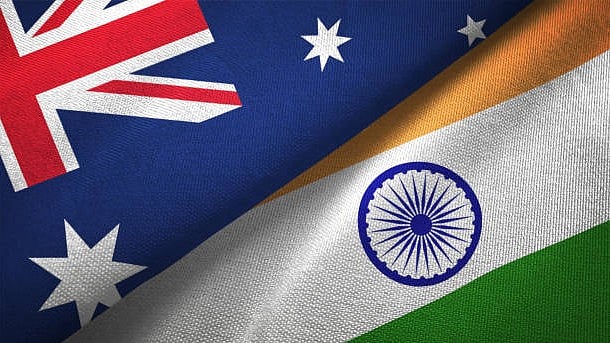
Flags of India and Australia.
Credit: iStock Photo
Chief of the Australian Army Lieutenant General Simon Stuart’s five-day India visit will be more than a ceremonial reaffirmation of friendship. It marks a strategic step forward in an already robust and deepening defence partnership between India and Australia. As the Indo-Pacific becomes more contested and China’s coercive manoeuvres intensify, frontline co-ordination between like-minded militaries is no longer a diplomatic nicety. It has become a necessity. The need to forge a concrete and workable strategy becomes even more important due to the ongoing tariff friction between India and the United States.
The August 10 to 14 visit will include high-level meetings with India’s Chief of Army Staff, General Upendra Dwivedi, and senior Ministry of Defence officials. This is a critical moment in a partnership fast becoming one of Indo-Pacific’s most consequential military relationships. For India and Australia, trust has matured into teeth.
From dialogue to deployment
While the broader Comprehensive Strategic Partnership (CSP), signed in 2020, has enabled multifaceted co-operation, it is the army-to-army relationship that now forms the sharp edge of this engagement. The bilateral exercise AUSTRA HIND, launched in 2016, has steadily grown in scope and complexity.
Focused on counter-terrorism, close-quarter battle, and joint tactical operations, it reflects the evolving battlefield realities both armies face. The upcoming edition in November, to be hosted in Australia, is expected to push the boundaries of interoperability in realistic terrain and combat scenarios.
Indian Army contingents have also actively participated in the exercise Talisman Sabre and the Indo-Pacific Endeavour series. These engagements go beyond tokenism — they reflect a willingness to operate in coalition environments, something that will prove vital in potential humanitarian crises, grey-zone flashpoints, or regional stabilisation efforts.
Institutional trust, operational confidence
A network of institutional mechanisms ensures ongoing engagement throughout the year. The army-to-army staff talks, initiated in 2010 and now held annually since 2016, have helped transform strategic intent into practical frameworks. These talks are complemented by defence policy dialogues, working groups, and frequent 2+2 ministerial dialogues.
Meanwhile, the India-Australia Young Officers Exchange Programme, conceptualised by late General Bipin Rawat and launched at the 2022 prime ministerial summit, is quietly shaping the future leadership ecosystem. Young officers today will be commanders tomorrow, and the mutual understanding built in these formative years could become the bedrock of coalition command synergy in a contested Indo-Pacific.
A two-way street
Defence education and knowledge exchange are equally strong pillars of support. Indian officers regularly attend Australia’s Army Command and Staff Course, Strategic Studies Course, and Combined Defence Intelligence programmes, while their Australian counterparts are embedded at India’s National Defence College, Defence Services Staff College, and Higher Defence Orientation Course.
The Instructor Exchange Programme at India’s Counter-Insurgency and Jungle Warfare School in Vairengte, Mizoram, reflects the tactical seriousness of the relationship. Subject Matter Expert Exchanges (SMEEs) continue to refine doctrinal understanding on topics ranging from Humanitarian Assistance and Disaster Relief (HADR) to jungle warfare to counter-terrorism. This joint training vocabulary cannot be built overnight.
Even alumni networks play a role: the 2024 ‘Dosti and Mateship in Defence’ alumni connect brought together officers trained at the NDC and the DSSC to reinforce long-term familiarity and continuity across ranks and generations.
From engagement to co-development
India’s private defence sector is also beginning to find a foothold in Australia. Indian firms have successfully exported tactical ISR platforms, protected mobility systems, and battlefield logistics technologies — a quiet but telling indicator of India’s growing defence industrial credibility.
A promising development is the Indian Army’s ongoing discussion with Australia’s Digger Works and India’s Army Design Bureau (ADB) on jointly developing battlefield solutions, particularly cost-effective, combat-tested technologies suitable for harsh operational environments.
What the visit must achieve
Stuart’s visit comes at a moment when India’s global defence posture is rising, as both a credible military partner and a net security provider in the Indian Ocean. The visit is more than symbolism. It is expected to build on shared operational experiences, reinforce strategic trust, and lay the groundwork for expanded collaboration in unmanned systems, cyber resilience, and multinational coalition readiness.
As China continues to exploit regional fault lines through coercion, economic leverage, and grey-zone tactics, India and Australia have little choice but to accelerate defence integration. This doesn’t imply entanglement in each other’s conflicts — rather, it points to a mutual recognition of shared risks and a shared commitment to preserving a free, open, and rules-based Indo-Pacific.
Strategic maturity, not strategic theatre
For much of the 2000s, India-Australia defence ties were polite but peripheral. Today, they are front and centre. Operational interoperability, institutional momentum, and a growing alignment of strategic worldviews back this shift. The relationship is no longer driven solely by ceremony, cricket, or culture. It is anchored in shared preparedness for a turbulent future.
India and Australia are learning, training, and planning together. The next step must be co-development, co-production, and — when necessary — collaboration. Because in this era of contested waters and sharpening edges, trusted militaries are the backbone of regional stability.
Lieutenant General Dushyant Singh (Retd) is Director General, Centre for Land Warfare Studies, New Delhi.